Key takeaways:
- Public health initiatives foster a sense of community and can lead to significant cost savings through preventive measures.
- Encouraging healthy habits creates a ripple effect, inspiring others and building accountability within communities.
- Effective strategies, such as leading by example and promoting education, can significantly enhance the adoption of healthy lifestyles.
- Sharing personal health stories and building supportive communities are powerful tools for motivation and accountability.

Understanding public health benefits
When I think about public health benefits, I often reflect on the sense of community that arises from improved health initiatives. For example, when my neighborhood organized a local health fair, it brought together families, friends, and even strangers, creating an atmosphere of support and motivation. Isn’t it uplifting to see people prioritize their well-being together?
Moreover, public health measures can lead to significant cost savings for individuals and communities. I remember a time when my workplace offered free flu vaccinations. Not only did it reduce sick days, but it also fostered a culture of preventive care. Isn’t it amazing how investing in health can yield such widespread benefits?
Sometimes, I ponder the broader impact of healthy populations on society. A person in good health is more productive, engaged, and able to contribute positively to their community. Have you ever considered how your own health impacts those around you? In my experience, fostering wellness not only enriches personal lives but also enhances the overall quality of life in our shared spaces.
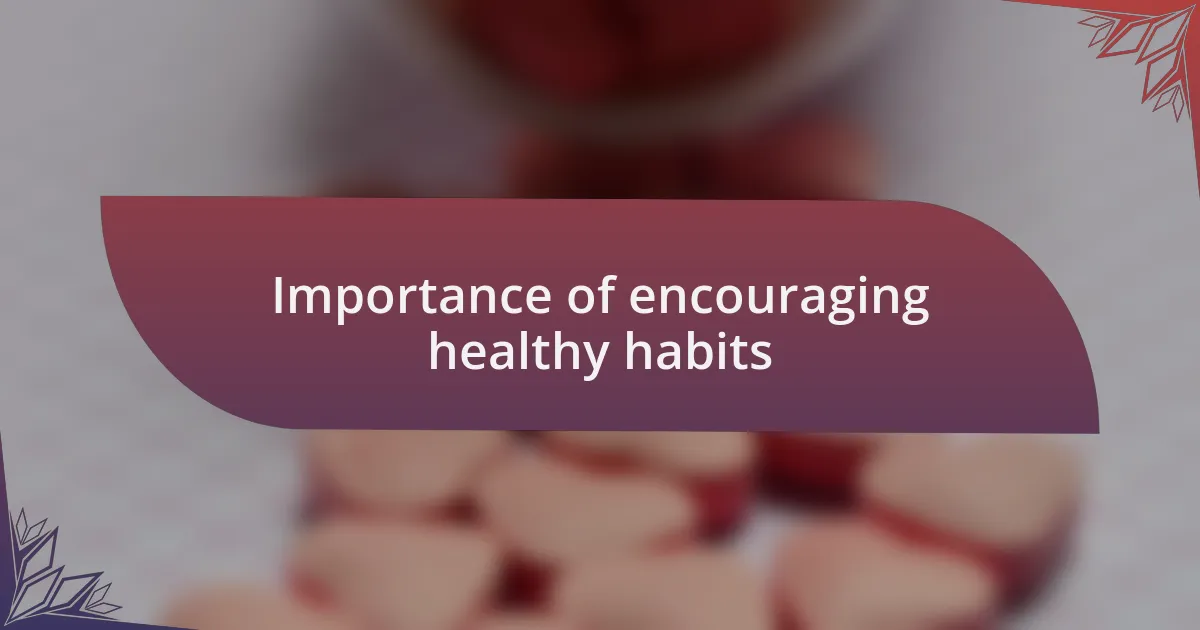
Importance of encouraging healthy habits
Encouraging healthy habits is crucial because it creates a ripple effect within communities. I’ve noticed that when I adopt healthier practices, like regular exercise or meal prepping, my friends and family often follow suit. Have you ever experienced that moment when someone asks you what sparked your change? It’s heartwarming to think that my choices can inspire others to prioritize their health as well.
I also believe that promoting healthy habits fosters resilience. When my friend decided to join me in a weekly yoga class, it transformed not only her physical health but also her mental well-being. We often talk about how that one class sparked a whole lifestyle shift for her. Don’t you think that having a support system makes such a difference in maintaining those habits?
Moreover, encouraging others to embrace a healthy lifestyle builds a sense of accountability. I often tell my colleagues about the benefits of staying active, and they share their fitness goals with me. That mutual encouragement makes it hard to backslide into old habits. Isn’t it remarkable how our individual efforts can forge a collective commitment to health?
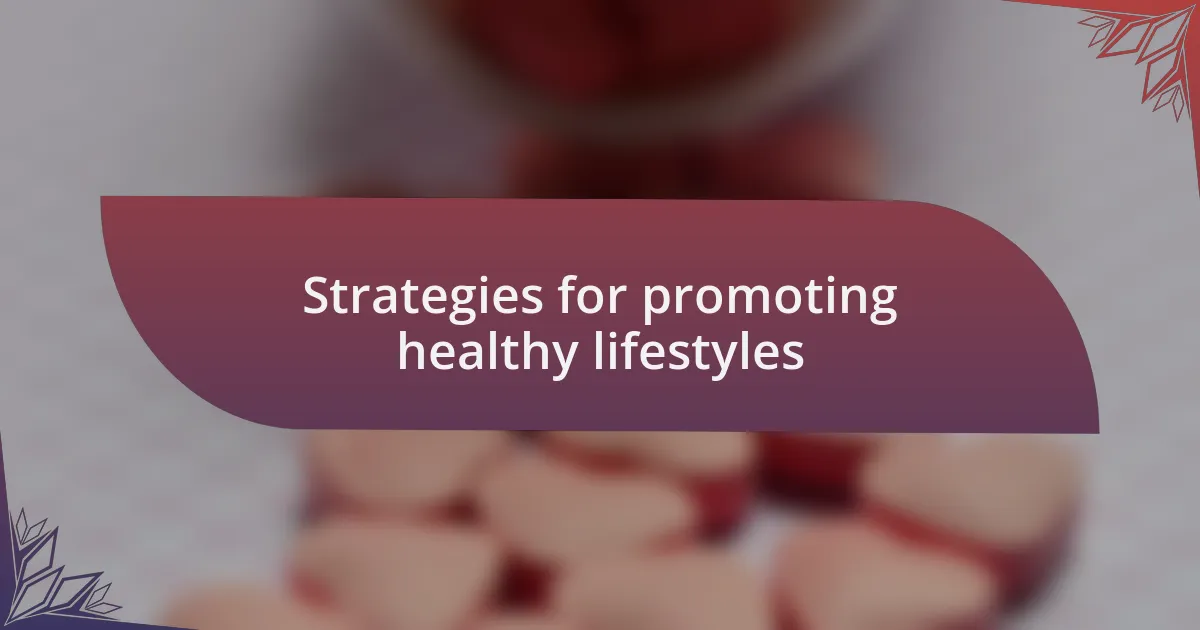
Strategies for promoting healthy lifestyles
One effective strategy I’ve found for promoting healthy lifestyles is leading by example. I remember when I started bringing healthy snacks to work; my coworkers were curious about my choices. Soon, many of them began to swap out their usual chips for fruit and nuts. Don’t you find it fascinating how a simple change can prompt a collective shift in behavior?
In addition, I believe in creating fun challenges within my community to inspire healthy habits. Last summer, I organized a friendly walking competition in my neighborhood. The excitement and camaraderie it fostered not only encouraged everyone to get moving but also deepened our sense of community. Have you ever participated in something similar that made you more active?
Lastly, I emphasize the importance of education in promoting a healthy lifestyle. I often share articles and resources that explain the benefits of various activities and diets. This approach really resonates with others, especially when they see the potential improvements in their own lives. What strategies have you tried to help educate friends and family about healthy living?
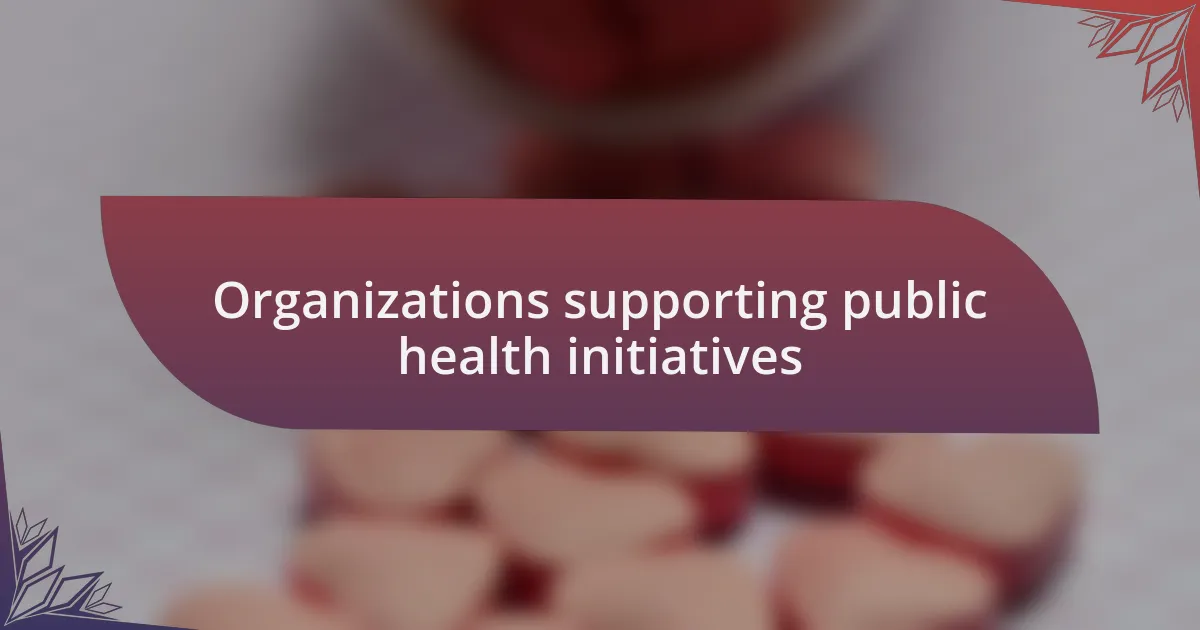
Organizations supporting public health initiatives
When it comes to supporting public health initiatives, organizations like the World Health Organization (WHO) play a pivotal role. I remember volunteering for a local health campaign that relied heavily on the data and guidelines published by the WHO. Their research-driven insights made it easier for us to convey vital health messages to the community, ensuring that we were addressing issues effectively. How often do we underestimate the power of authoritative guidance in our health initiatives?
In addition to global leaders like WHO, local organizations can also make a significant impact. For instance, I participated in a workshop hosted by a community health group that educated participants about nutrition and physical activity. The passion these organizations exhibit fosters enthusiasm, and seeing my neighbors become more informed and engaged in their health really motivated me to continue my advocacy. Have you ever seen a community rally together for a common cause and felt inspired by the collective effort?
Moreover, partnerships between these organizations and local governments often amplify their effectiveness. I recall a project where a local health department collaborated with a nonprofit to offer free health screenings in our area. The excitement was palpable; it felt like we were creating tangible change. This experience made me realize that when organizations unite for public health initiatives, the results can be profound. Have you witnessed similar collaborations in your community that brought about real improvements?
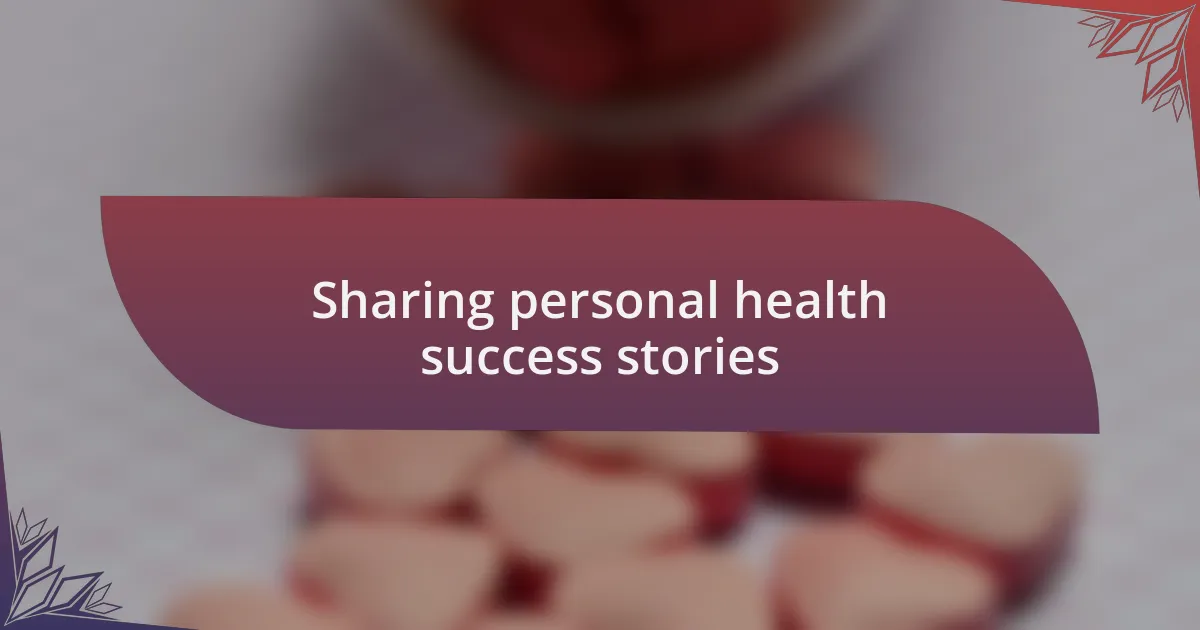
Sharing personal health success stories
Sharing personal health success stories can be an incredibly powerful tool for encouraging others. For instance, I once shared my journey of losing weight after years of struggling with my diet and exercise routines. As I detailed my ups and downs, I watched the eyes of my friends light up with understanding and hope. Isn’t it amazing how personal experiences can resonate so deeply with others, transforming numbers on a scale into relatable stories of perseverance?
One memorable occasion was when I organized a small gathering where individuals could share their health journeys. The room was filled with laughter, tears, and moments of vulnerability as people opened up about their battles and victories. Hearing someone express their breakthrough moment reminded me of my own; it was a vivid reminder that sometimes just knowing we’re not alone can be the encouragement we need. How often do we realize that sharing our struggles creates a sense of community that empowers everyone to seek healthier paths?
Moreover, I’ve noticed that when I celebrate the successes of others, it creates a ripple effect. A friend who overcame anxiety through yoga began teaching classes, and I believe my initial encouragement sparked her journey. Seeing her thrive not only motivates me but also inspires others to pursue their own wellness journeys. Isn’t it fascinating how interconnected our stories can be, each one paving the way for another?
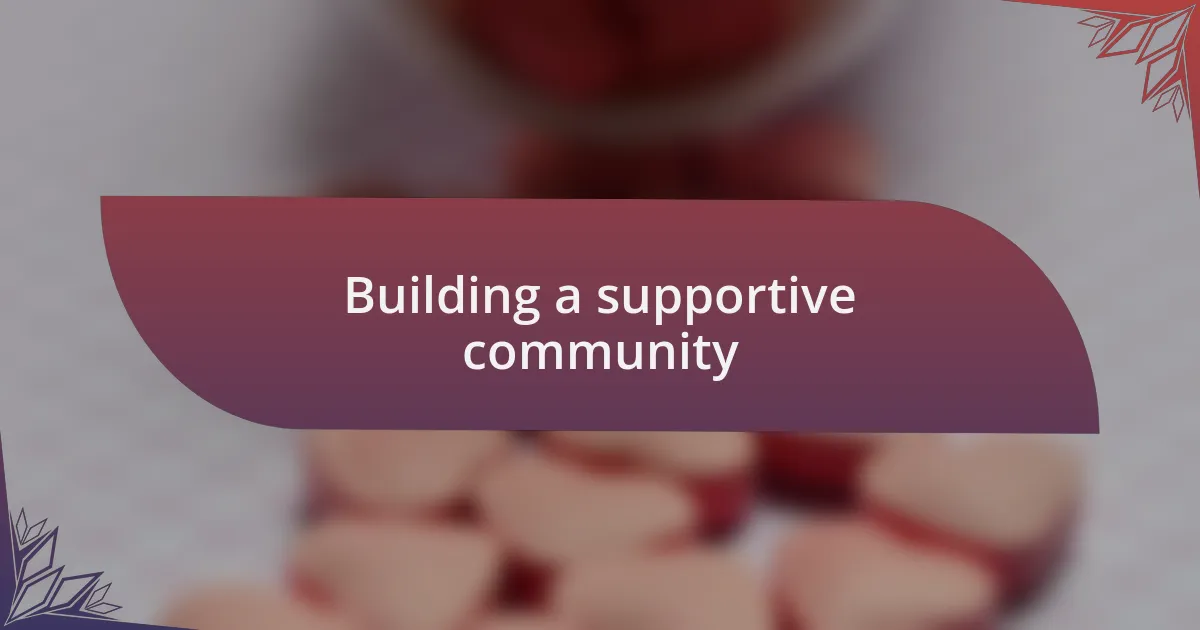
Building a supportive community
Building a supportive community is all about fostering connections that nurture wellbeing. I often think back to my local running club, where athletes of all levels come together. It’s not just about hitting distances; it’s the camaraderie that makes early morning runs feel more like gatherings of friends rather than solitary workouts. Can you imagine how encouraging it is to hear someone cheer you on when you’re struggling to finish that last mile?
During one of our group sessions, I noticed a new member who was visibly apprehensive about joining in. After some gentle nudging from the group, they opened up about their fitness journey, and before long, everyone was sharing tips and experiences. The transformation was incredible! That initial vulnerability created an atmosphere of acceptance, allowing everyone to feel comfortable sharing their own challenges. Isn’t it interesting how one person’s courage can cultivate a safe space for others?
In some of my experiences, I’ve found that simply checking in on someone can make a huge difference. I remember a friend who got overwhelmed during a particularly stressful time. By inviting her to join a meal prep day, I not only helped her save time but also created an opportunity for us to bond over healthy choices. These little acts of kindness remind us that we’re all in this together, with each supportive gesture reinforcing the fabric of our community. What can you do today to uplift someone in your circle?

Tools for effective health communication
Effective health communication relies heavily on choosing the right tools to convey important messages. I remember organizing a health workshop where we used simple visual aids like infographics to illustrate nutritional information. When participants saw the colorful display of food groups, it not only simplified the message but also captivated their attention. Isn’t it fascinating how a visual can sometimes communicate more than a thousand words?
Social media platforms have also become invaluable in disseminating health information. I’ve often shared articles and resources on my profiles, which sparked conversations among friends and family about healthy living. It’s remarkable how a single post can lead to a lively discussion on meal planning or exercise routines. Have you ever noticed how much easier it is to engage with someone online about health topics compared to face-to-face?
In my own journey encouraging others, I’ve found that storytelling can create a powerful connection. I like to share my personal struggles with maintaining a balanced diet, which often opens the floor to others sharing their own experiences. This exchange not only normalizes challenges but also builds trust, making it easier for individuals to seek guidance. How often do we underestimate the impact of sharing our personal stories in inspiring change?